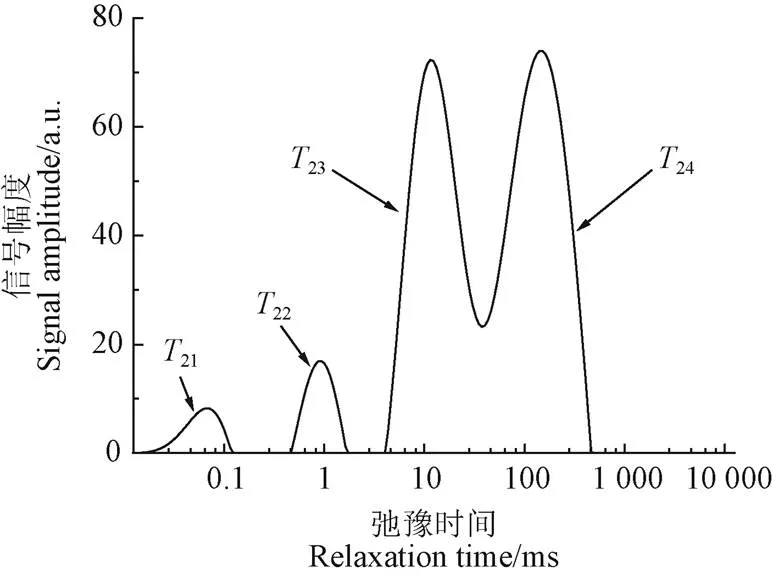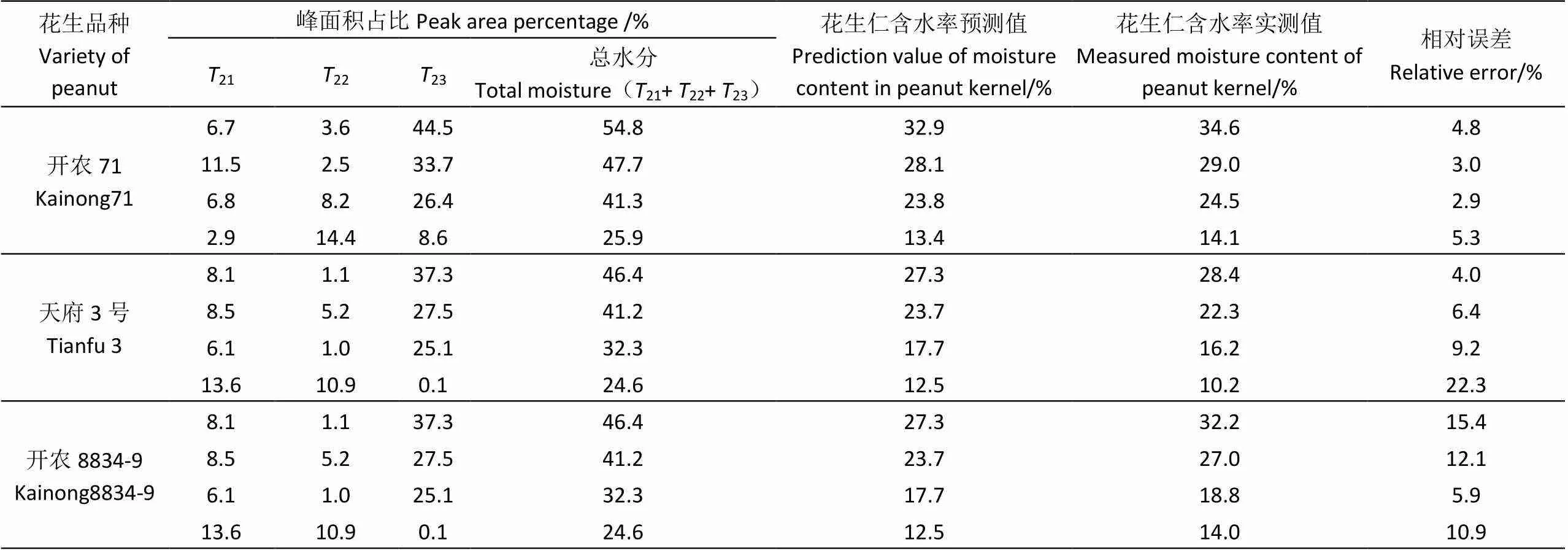基于低场核磁共振的热风干燥过程花生仁含水率预测模型
2019-08-19渠琛玲汪紫薇王雪珂王殿轩
渠琛玲,汪紫薇,王雪珂,王殿轩
基于低场核磁共振的热风干燥过程花生仁含水率预测模型
渠琛玲,汪紫薇,王雪珂,王殿轩※
(河南工业大学粮油食品学院,郑州 450001)
为研究热风干燥过程中花生仁内部水分的变化规律,该文采用热空气对开农71、开农8834-9、天府3号3个品种的湿花生进行干燥,监测干燥过程中花生果、花生仁与花生壳含水率的变化;并利用低场核磁共振技术(LF-NMR)研究干燥过程中花生仁内部自由水、弱结合水和结合水的变化情况;建立花生仁水分弛豫峰占比与其含水率之间的数学关系,提出了一种花生含水率的快速检测方法。结果表明,由于花生仁和花生壳化学组成不同,仁和壳干燥曲线呈现不同的变化趋势。LF-NMR弛豫图谱显示干燥过程中,自由水弛豫峰逐渐消失,结合水和弱结合水弛豫峰面积无明显变化规律,油脂峰峰面积基本不变,说明花生仁在干燥过程中油脂的含量无明显变化。建立的花生仁国标法实测含水率与核磁共振弛豫谱图得到的总水分峰占比(21+22+23)的拟合方程2为0.888 4。经验证,该方程能较好地对未知含水率的花生仁样品进行预测。因此,低场核磁共振技术可以用于花生仁含水率的快速检测。
含水率;干燥;核磁共振;花生;热风;弛豫峰
0 引 言
花生是中国主要油料经济作物之一,具有较高的经济价值[1]。花生品种繁多,有记录依据的大约有540种,其中优良品种有30种,如果按荚果大小划分,一般将花生分为大花生和小花生[2],如果按油酸含量划分,可以分为高油酸花生与普通花生[3-5]。刚收获的花生含水量很高,约为40%~60%,且花生收获季节极易遇到阴雨天气,若不及时干燥极易发热霉变,严重时还会产生黄曲霉毒素[6]。因此,收获后的湿花生要及时干燥,以利于后期储存和加工[7-10]。一般将花生果水分降到10%以下或花生仁水分降至8%左右可安全储存不霉变(NY/T 2390—2013)。
目前中国花生干燥仍以自然晾晒为主,但这种方法耗时长,并需要足够的晒场,而且依赖天气。而花生收获后采用热风干燥,可以不受环境、场地等外界条件的限制,现逐渐得到应用推广[11-13]。
目前花生含水率的测定方法以GB 5009.3—2016中的烘箱法为标准方法,但这种含水率测定方法的主要缺点为耗时较长。1H-低场核磁共振技术是近年来兴起的一种用于快速测定样品中结合水、半结合水、自由水的新技术[14-17]。1H-低场核磁共振主要通过测量质子纵向弛豫时间(1)和横向弛豫时间(2)来揭示质子(1H)的运动[18-20]。花生中1H-核磁共振吸收的物理基础是其所含的脂肪、蛋白质、碳水化合物及水的-H基产生,由于各种组分原子的局域场及其内部相互作用机制不同[21-23],它们所产生的共振吸收频率化学位移及对应的寿命(弛豫时间)也不相同[24-25],在干燥的过程中,花生仁中水分子与大分子之间的相互作用一直在变化[26-28]。
本文针对花生品种的多样性,从果型和油酸含量的角度出发,以开农71(大果、高油酸)、开农8834-9(大果、普通型)、天府3号(小果、普通型)3个品种的湿花生为研究对象,对不同品种的花生果、花生仁和花生壳干燥过程中水分的变化规律进行研究。并通过标识干燥过程中花生仁的核磁共振横向弛豫谱,分析干燥过程中不同品种的花生仁内自由水、弱结合水和结合水的变化情况,找出不同品种花生干燥内部水分变化是否存在共性规律。根据花生干燥数据,建立花生仁含水率与弛豫谱峰之间的数学关系式,用于预测其它品种花生仁的含水率,以期为花生干燥过程中水分的快速检测提供一种可行的方法。
1 试验材料与仪器
1.1 试验材料
本试验选用了3个花生品种,原料性质如表1所示。
1.2 试验设备
干燥设备由本单位设计,委托郑州万谷机械有限公司制作,干燥设备示意图如图1所示。设备核心部件为高660 mm,直径285 mm的烘干筒,装料量约15 kg湿花生果。流量计:UGB-2306-B,上海求精流量仪表有限公司。变频调速三相异步电动机:WF2-90S-2,安徽皖南电机股份有限公司。

表1 花生原料

1.电脑 2.温湿度传感器 3.冲孔钢板 4.空气分配室 5.湿花生 6.烘干筒 7.流量计 8.阀门 9.离心风机 10.加热箱
变温型核磁共振食品农业成像分析仪:Micro MR-CL-I,上海纽迈电子科技有限公司;电子天平:ML204,梅特勒-托利多仪器上海有限公司;电热鼓风恒温干燥箱:101A-1,上海市崇明实验仪器厂。
2 试验方法
2.1 花生热风干燥
将3个品种的湿花生分别在风温35℃、风速0.6 m/s的条件下(参考NY/T 2390—2013)通风干燥,当花生果含水率降到10%以下且花生仁水分降至8%以下时停止干燥。在干燥过程中每2 h测一次花生果、花生仁和花生壳的含水率;以干基含量为基准,定时(时间间隔2~6 h)取样0.3 g(3次平行试验),使用变温型核磁共振食品农业成像分析仪对花生仁进行扫描测定。
2.2 水分测定方法
花生果、花生壳和花生仁的湿基含水率参照GB/T 5497—1985与GB/T 5009.3—2016进行测定。
2.3 低场核磁共振测定水分
试验条件:主磁场强度0.51 T,其对应共振频率为20 MHz,样品室温度为(35.00±0.01)℃,采用CPMG(18-10-18-101619-0)脉冲序列测定样品的横向弛豫时间(2)。CPMG序列采用的参数:采样点数TD为333 332,回波个数NECH设置为10 000,回波时间TE为0.100 ms,采样率为333.333 kHz,重复采样时间间隔为3 000 ms,根据样品实际情况,重复采样次数为16。选用变温型核磁共振食品农业成像分析仪配套的反演软件进行连续谱迭代分析拟合得到各样品的波谱图和2值,运算参数:开始时间0.01 ms,截止时间1 000 ms,参与反演点数199。
2.4 数据处理方法
使用Orgin 9.0和SPSS 22.0进行数据处理和分析。
3 结果分析
3.1 湿花生的干燥曲线
开农71、天府3号与开农8834-9 3个品种湿花生热风干燥过程中花生果、花生壳与花生仁水分变化如图2所示。随着干燥时间的延长,花生壳含水率干燥初始阶段下降最快,下降趋势为先快速下降后缓慢下降,这是因为花生壳的结构为孔隙较大的纤维组织,壳内水分容易散失。而花生仁的含水率下降较慢,这是由于花生仁富含蛋白质,蛋白质为亲水物质,所以花生仁较花生壳难干燥,且干燥过程中,花生仁与花生壳逐渐分开形成空气层,对花生仁的传热和传质形成阻碍[29-30]。

图2 开农71、天府3号和开农8834-9花生果、花生仁和花生壳干燥曲线
综合以上数据和分析可知,3个品种的花生在干燥过程中,花生果、花生壳和花生仁都分别表现出了相似的降水规律。
3.2 花生仁T2弛豫图谱
图3为花生仁核磁共振信号强度与弛豫时间关系图,本试验中湿花生的2弛豫图谱的主要弛豫峰有4个,0.1、1、10、100 ms弛豫时间位置21、22、23、24分别对应结合水、弱结合水、自由水、油脂的弛豫峰[17,19,23]。

注:T21、T22、T23、T24分别对应结合水、弱结合水、自由水、油脂的弛豫峰。下同。
3.3 花生仁干燥过程中核磁共振横向弛豫谱图的变化
图4为开农71高油酸花生(初始含水率35.9%)在干燥过程的横向弛豫谱图(天府3号和开农8834-9 2个品种的花生仁干燥过程谱图与开农71相似)。在整个干燥过程中,观察到21、22、23和244个主要峰,其中在干燥前(0 h),花生的23和24峰是有重叠的,这是由于自由水与油脂弛豫时间较为接近,且二者含量都很高。随着干燥时间的延长,23峰面积明显减少,24峰面积基本不变,23和24处的峰逐渐分开,干燥至40 h,23峰完全消失。21在干燥过程中基本不变说明花生在干燥过程中,结合水的量基本不变。
3.4 花生仁干燥过程中各峰峰比例和峰面积的变化
表2为开农71高油酸花生仁各质子峰峰比例、油脂峰峰面积及含水率随干燥过程的变化情况。在干燥过程中,23峰比例在逐渐减小,说明自由水含量逐渐下降;22峰比例为先升高,但在34~40 h时22峰比例有所下降,说明弱结合水含量在干燥末期也有所降低。由此可知,花生在干燥过程中散失的水分主要为自由水及部分弱结合水。根据显著性分析,干燥过程中的油脂峰峰面积没有显著性差异,说明在干燥过程中油脂的含量无明显变化。

a. 0 hb. 10 hc. 22 hd. 40 h

表2 各峰峰面积占比、油脂峰峰面积、花生仁含水率随时间的变化(开农71)
注:表中同列数据后小写字母分别表示0.05水平差异显著,下同。
Note: The lowercase letters of the same column data in the table showed significant difference at 0.05 level, the same below.
表3为天府3号小果普通型花生仁在不同干燥时间4个质子峰的峰比例、油脂峰峰面积及含水率。与开农71高油酸花生相似,21与24峰比例在逐渐上升,23峰比例在逐渐下降,22峰比例先升高在末期下降。可知天府3号花生仁干燥过程中失去的也主要为自由水和部分弱结合水。由显著性分析可知天府3号花生仁在干燥过程中油脂的含量也无明显变化。
表4为开农8834-9花生仁在不同干燥时间4个质子峰的峰比例、油脂峰峰面积及含水率。开农8834-9与开农71和天府3号花生类似,在干燥过程中23峰比例大致呈逐渐减小的趋势,21与24峰比例大致为逐渐增大趋势,22峰比例为先增大,后面在36~42 h之间有所下降,说明开农8834-9花生在干燥过程中散失水分也主要为自由水和部分弱结合水。油脂峰峰面积在干燥过程中无显著性差异,说明开农8834-9花生仁在干燥过程中油脂的含量也无明显变化。

表3 各峰峰面积占比、油脂峰峰面积、花生仁含水率随时间的变化(天府3号)

表4 各峰峰面积占比、油脂峰峰面积、花生仁含水率随时间的变化(开农8834-9)
3.5 总水分峰比例与含水率数学关系式的拟合与验证
3.5.1 总水分峰比例与含水率数学关系式的拟合
如表2、表3和表4所示,以上述3个品种花生仁核磁共振弛豫谱图得到的总水分峰占比(21+22+23)为,花生仁国标法实测含水率为,建立拟合方程(1)。
=0.677 6-4.190 2 (2=0.888 4) (1)
3.5.2 花生仁水分拟合方程的验证
另取3个花生品种的湿花生样品再进行干燥试验,取干燥过程的花生仁样品进行低场核磁共振扫描,所得结合水、弱结合水和自由水的峰面积占比和总水分峰面积占比如表5所示。将3个品种花生仁总水分的峰面积占比分别代入方程(1)中,计算出花生仁含水率的预测值。同时取样采用国标方法测定花生仁的水分,得到花生仁含水率的实测值,并计算预测值和实测值之间的相对误差,结果如表5所示。

表5 花生仁含水率预测值与实测值比较


国标GB 5009.3—2016中传统的水分测定方法要求相对误差不超过10%。由表5可知,拟合方程所得预测值与实测值之间的相对误差在2.9%~22.3%之间,这主要是由于花生的品种与个体差异较大,但总的来说能较好地预测花生含水率。因此,利用低场核磁共振技术建立的预测方程可以用于快速测定花生仁的含水率。
4 结 论
1)本文对开农71、天府3号与开农8834-9 3个品种的湿花生采用35℃、0.6 m/s的热风进行干燥。不论花生的油酸含量及果型的大小,3个品种的花生干燥过程中表现出了相似的干燥特性,其花生果和花生仁的含水率都均匀下降,花生仁的含水率均先快速下降再缓慢下降。
2)3个品种的花生仁的低场核磁共振弛豫谱图均有4个主要的峰,分别为自由水峰、弱结合水峰、结合水峰和油脂峰。3个品种的花生仁在干燥过程中,自由水峰都逐渐下降,至干燥结束后几近消失;结合水峰和弱结合水峰的峰面积变化无明显规律;油脂峰峰面积无显著变化,说明在干燥过程中花生仁中油脂含量不变。
3)3个品种的花生仁低场核磁共振弛豫谱图中各弛豫峰峰比例随干燥进行,也呈相似的变化趋势。结合水峰和油脂峰峰比例均呈现上升趋势;自由水峰峰比例呈下降趋势,干燥结束时,已经很低,说明干燥结束时自由水几乎完全失去;弱结合水峰峰比例呈上升趋势,至干燥结束前呈现下降趋势,说明在干燥结束时,失去了部分弱结合水。由此可知,在干燥过程中,主要散失水分为自由水与弱结合水。
4)以花生仁的核磁共振弛豫谱图得到的总水分峰占比(21+22+23),花生仁国标法实测含水率建立的线性方程的2为0.888 4。用3个品种不同含水率的花生仁进行方程的验证,结果较好。因此,低场核磁共振可作为花生仁含水率快速检测的参考方法。
[1] 周瑞宝. 花生加工技术[M]. 北京:化学工业出版社,2003.
[2] 布衣. 花生的种类[J]. 农村实用技术,2013(10):50.
[3] Toborek M, Lee Y W, Garrido R, et al. Unsaturated fatty acids selectively induce an inflammatory environment in human endothelial cells[J]. American Journal of Clinical Nutrition, 2002, 75(1): 119-125.
[4] 陈静. 高油酸花生遗传育种研究进展[J]. 植物遗传资源学报,2011,12(2):190-196. Chen Jing. Advances in genetics and breeding of high oleic acid peanut[J]. Journal of Plant Genetic Resources, 2011, 12(2): 190-196. (in Chinese with English abstract)
[5] 曲奕威,任春玲,姜玉忠. 河南省高油酸花生的发展情况与展望[J]. 河南农业,2018(31):12.
[6] 李建辉. 花生中黄曲霉毒素的影响因子及脱毒技术研究[D].北京:中国农业科学院,2009. Li Jianhui. Impact Factor and Detoxification of Aflatoxins in Peanuts[D]. Chinese Academy of Agricultural Sciences, 2009. (in Chinese with English abstract)
[7] 尹慧敏,吴文福,窦建鹏,等. 热风干燥条件对马铃薯全粉糊化品质的影响[J]. 农业工程学报,2017,33(12):293-300. Yin Huimin, Wu Wenfu, Dou Jianpeng, et al. Influence of hot-air drying condition on dehydrated potato flour gelatinization quality[J]. Transactions of the Chinese Society of Agricultural Engineering (Transactions of the CSAE), 2017, 33(12): 293-300. (in Chinese with English abstract)
[8] 陈良元,韩李锋,李旭,等. 茄子片热风干燥收缩特性及其修正的湿分扩散动力学模型[J]. 农业工程学报,2016,32(15):275-281.Chen Liangyuan, Han Lifeng, Li Xu, et al. Structural shrinkage characteristics and modified moisture diffusion kinetics model of sliced eggplant dried by hot air[J]. Transactions of the Chinese Society of Agricultural Engineering (Transactions of the CSAE), 2016, 32(15): 275-281. (in Chinese with English abstract)
[9] 白竣文,田潇瑜,刘宇婧,等. 大野芋薄层干燥特性及收缩动力学模型研究[J]. 中国食品学报,2018,18(4):124-131. Bai Junwen, Tian Xiaoyu, Liu Yujing, et al. Studies on drying characteristics and shrinkage kinetics modelling of colocasia gigantea slices during thin layer drying[J]. Journal of Chinese Institute of Food Science and Technology, 2018, 18(4): 124-131. (in Chinese with English abstract)
[10] 张赛,陈君若,刘显茜. 水果在热风干燥中的水分扩散分形模型[J]. 农业工程学报,2014,30(4):286-292. Zhang Sai, Chen Junruo, Liu Xianqian. Diffusion fractal model of fruit moisture in hot air drying[J]. Transactions of the Chinese Society of Agricultural Engineering (Transactions of the CSAE), 2014, 30(4): 286-292. (in Chinese with English abstract)
[11] Fernandes F A N, Rodrigues S, Law C L, et al. Drying of exotic tropical fruits: A comprehensive review[J]. Food & Bioprocess Technology, 2011, 4(2): 163-185.
[12] 王安建,高帅平,田广瑞,等. 花生热泵干燥特性及动力学模型[J]. 农产品加工,2015(9):57-60. Wang Anjian, Gao Shuaiping, Tian Guangrui, et al. Heat pump drying characteristics and dynamics model of peanut[J]. Farm Products Processing, 2015(9): 57-60. (in Chinese with English abstract)
[13] 颜建春,胡志超,谢焕雄,等. 花生荚果薄层干燥特性及模型研究[J].中国农机化学报,2013,34(6):205-210. Yan Jianchun, Hu Zhichao, Xie Huanxiong, et al. Studies of thin-layer drying characteristics and model for peanut pods[J]. Journal of Chinese Agricultural Mechanization, 2013, 34(6): 205-210. (in Chinese with English abstract)
[14] 王新兵,李丽云,丁广良,等. 猕猴桃的磁共振成象及核磁共振定域波谱研究[J]. 波谱学杂志,1998(3):261-266. Wang Xinbing, Li Liyun, Ding Guangliang, et al. The study of kiwi using magnetic resonance imaging and localized NMR spectroscopy[J]. Chinese Journal of Magnetic Resonance, 1998(3): 261-266. (in Chinese with English abstract)
[15] 张建锋,吴迪,龚向阳,等. 基于核磁共振成像技术的作物根系无损检测[J]. 农业工程学报,2012,28(8):181-185. Zhang Jianfeng, Wu Di, Gong Xiangyang, et al. Non-destructive detection of plant roots based on magnetic resonance imaging technology[J]. Transactions of the Chinese Society of Agricultural Engineering (Transactions of the CSAE), 2012, 28(8): 181-185. (in Chinese with English abstract)
[16] 李然,李振川,陈珊珊,等. 应用低场核磁共振研究绿豆浸泡过程[J]. 食品科学,2009,30(15):137-141. Li Ran, Li Zhenchuan, Chen Shanshan, et al. Study of water absorption of mung beans based on low-field nuclear magnetic resonance technology[J]. Food Science, 2009, 30(15): 137-141. (in Chinese with English abstract)
[17] 付晓记,唐爱清,闵华,等. 花生浸种过程中水分相态和水分迁移动态研究[J]. 中国油料作物学报,2018,40(4):552-557.
[18] 孙炳新,赵宏侠,冯叙桥,等. 基于低场核磁和成像技术的鲜枣贮藏过程水分状态的变化研究[J]. 中国食品学报,2016,16(5):252-257. Sun Bingxin, Zhao Hongxia, Feng Xuqiao, et al. Studies on the change of moisture state of fresh jujube during storage base on LF-NMR and MRI[J]. Journal of Chinese Institute of Food Science and Technology, 2016, 16(5): 252-257. (in Chinese with English abstract)
[19] 马彦宁,钱建强,回朝阳,等. 油料种子含油含水率的CPMG序列核磁共振测量[J]. 大学物理,2018,37(7):78-81. Ma Yanning, Qian Jianqiang, Hui Zhaoyang, et al. The NMR measuring of oil and moisture content of oil seeds based on the CPMG sequence[J]. College Physics, 2018, 37(7): 78-81. (in Chinese with English abstract)
[20] Rnm P, Gamr L. Nuclear magnetic resonance and water activity in measuring the water mobility in Pintadocorruscans) fish[J]. Journal of Food Engineering, 2003, 58(1): 59-66.
[21] Mcentyre E, Ruan R, Fulcher R G. Comparison of water absorption patterns in two barley cultivars, using magnetic resonance imaging[J]. Cereal Chemistry, 1998, 75(6): 792-795.
[22] Li L, Zhang M, Bhandari B, et al. LF-NMR online detection of water dynamics in apple cubes during microwave vacuum drying[J]. Drying Technology, 2018, 36(16): 77568-77577.
[23] 李潮锐,刘青,杨培强. 鲜花生的低场核磁共振横向弛豫分析[J]. 中山大学学报:自然科学版,2014,53(2):1-5.
[24] 李娜,李瑜. 利用低场核磁共振技术分析冬瓜真空干燥过程中的内部水分变化[J]. 食品科学,2016,37(23):84-88. Li Na, Li Yu. Analysis of internal moisture changes of benincasa hispida during vacuum drying using low-field NMR[J]. Food Science, 2016, 37(23): 84-88. (in Chinese with English abstract)
[25] 张楠,庄昕波,黄子信,等. 低场核磁共振技术研究猪肉冷却过程中水分迁移规律[J]. 食品科学,2017,38(11):103-109.
[26] Zang X, Lin Z, Zhang T, et al. Non-destructive measurement of water and fat contents, water dynamics during drying and adulteration detection of intact small yellow croaker by low field NMR[J]. Journal of Food Measurement & Characterization, 2017,11(4): 1550-1558.
[27] 蔡健荣,卢越,白竣文,等. 马铃薯薄片干燥过程形态变化三维成像[J]. 农业工程学报,2019,35(1):278-284. Cai Jianrong, Lu Yue, Bai Junwen, et al. Three-dimensional imaging of morphological changes of potato slices during drying[J]. Transactions of the Chinese Society of Agricultural Engineering (Transactions of the CSAE), 2019, 35(1): 278-284. (in Chinese with English abstract)
[28] 李晓斌,郭玉明,崔清亮,等. 用图像法分析茄子在冻干过程中的水分动态运移规律[J]. 农业工程学报,2016,32(1):304-311. Li Xiaobin, Guo Yuming, Cui Qingliang, et al. Moisture diffusion and transfer dynamic analysis of eggplant during vacuum freeze-drying based on image processing technique[J]. Transactions of the Chinese Society of Agricultural Engineering (Transactions of the CSAE), 2016,32(1): 304-311. (in Chinese with English abstract)
[29] 刘宗博,张钟元,李大婧,等. 双孢菇远红外干燥过程中内部水分的变化规律[J]. 食品科学,2016,37(9):82-86. Liu Zongbo, Zhang Zhongyuan, Li Dajing , et al. Analysis of moisture change during far-infrared drying of agaricus bisporus[J]. Food Science, 2016, 37(9): 82-86. (in Chinese with English abstract)
[30] 朱丹实,王立娜,吴晓菲,等. 冰温及冷藏对鲤鱼水分迁移及质构的影响[J]. 中国食品学报,2017,17(10):152-159. Zhu Danshi, Wang Lina, Wu Xiaofei, et al. Effects of the ice storage and cold storage on migration of moisture and texture changes of carp[J]. Journal of Chinese Institute of Food Science and Technology 2017, 17(10): 152-159. (in Chinese with English abstract)
Prediction model of moisture in peanut kernel during hot air drying based on LF-NMR technology
Qu Chenling, Wang Ziwei, Wang Xueke, Wang Dianxuan※
(,,450001,)
Peanut, which has high economic value, is one of the main oil crops in China. Freshly harvested peanuts usually had high moisture contents, which were about 40%-60%. If peanuts with high moisture content did not dry in time, it was easy to fever and mildew. So it is very important for peanuts drying in time. In this paper, three varieties of wet peanuts, Kainong 71, Kainong 8834-9 and Tianfu 3, were dried by hot air, which temperature was 35 ℃ and air velocity was 0.6 m/s. And the moisture contents of peanuts, peanut kernels and peanut shells were monitored during the drying process. The changes of free water, weak-bound water and bound water in peanut kernels during drying were studied by low-field nuclear magnetic resonance (LF-NMR) technology. The common law of internal moisture changes in peanut kernels during drying process was obtained. The mathematical relationship between the total percentage of moisture relaxation peaks in peanut kernels and their moisture contents determined by the national standard method was established. A rapid detection method of peanut moisture contents was proposed in this paper, which had a practical significance for peanut storage and processing. The results showed that regardless of the amount of oleic acid in peanuts and the size of the peanuts, the drying characteristics of the three varieties of peanuts were similar. The moisture contents of the three varieties of peanut and peanut kernel showed different downward trend compared to the peanut shell. The moisture contents of peanut shell first declined rapidly in the early stage (2-4 h), then slowly due to their fiber structure. The LF-NMR relaxation spectra of peanut kernels of the three varieties all had four main peaks, namely, free water peak, weak-bound water peak, bound water peak and oil peak. During the drying process, the free water peak areas of peanut kernels of the three varieties decreased gradually, and almost disappeared at the end of drying. The changing trends of the weak-bound water and bound water peak areas were obvious. The peak areas of oil peaks did not change significantly, indicating that the oil content in peanut kernels remained unchanged during drying process. The relaxation peak area ratios of peanut kernels of the three varieties in low-field NMR relaxation spectra also showed similar trends during drying. The percentages of bound water peak area and oil peak area showed an upward trend. The percentage of free water peak area showed a downward trend, which was very low at the end of drying, indicating that free water almost completely lost at the end of drying. The percentage of weak-bound water peak area firstly rose, then declined at the end of drying, indicating that some weak-bound water was lost. Therefore, free water and weak-bound water were the main kind lost water in the drying process. In addition, it could be judged that if the relaxation peak of free water disappeared or the peak was very small, the moisture contents of peanut kernels were below the safe storage moisture content. The2of equation established to predict the moisture content of peanut kernel is 0.888 4. The equation has been validated and the fitting results were good. Therefore, the LF-NMR technology can be used for rapid detection of moisture content in peanut kernels.
moisture; drying; nuclear magnetic resonance; peanut; hot air; relaxation peak
2019-01-24
2019-05-11
国家花生产业技术体系(CARS-13)
渠琛玲,博士,副教授,主要从事粮食干燥与储藏研究。Email:quchenling@163.com
王殿轩,博士,教授,博士生导师,主要从事储藏物害虫综合治理研究。Email:wangdianxuan62@126.com
10.11975/j.issn.1002-6819.2019.12.035
TS210.2
A
1002-6819(2019)-12-0290-07
渠琛玲,汪紫薇,王雪珂,王殿轩. 基于低场核磁共振的热风干燥过程花生仁含水率预测模型[J]. 农业工程学报,2019,35(12):290-296. doi:10.11975/j.issn.1002-6819.2019.12.035 http://www.tcsae.org
Qu Chenling, Wang Ziwei, Wang Xueke, Wang Dianxuan. Prediction model of moisture in peanut kernel during hot air drying based on LF-NMR technology[J].Transactions of the Chinese Society of Agricultural Engineering (Transactions of the CSAE), 2019, 35(12): 290-296. (in Chinese with English abstract) doi:10.11975/j.issn.1002-6819.2019.12.035 http://www.tcsae.org
